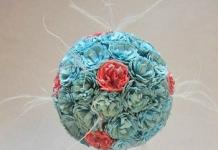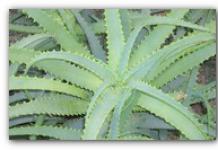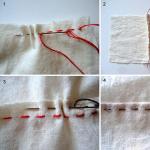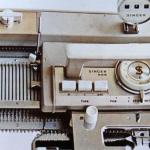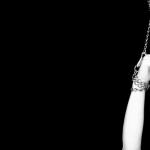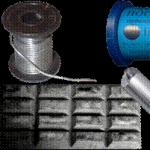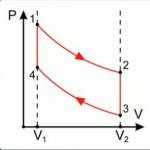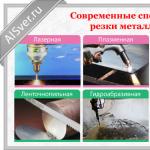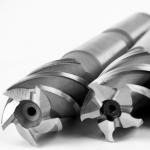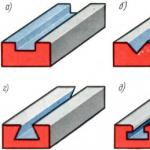I still remember the time when I needed a snowflake dress for a matinee, and it was a problem to buy it in a store. So my mother had to take and sew this dress with her own hands. We had at home sewing machine, but it was not super cool and often broke down, and it was difficult to fix it ...
And some things, including this snowflake dress, my mother sewed for me with the help of some hand stitches. The outfit was excellent and if it weren’t for the fact that the dress was themed and I had to wear it only once, it could have lasted a very long time due to its tailoring quality. Not like today's Chinese things, sewn with rotten threads and somehow hastily on a sewing machine.
Earlier handmade things not valued as much as they are now. Being in Italy a month ago, I saw excellent women's and men's suits of incredible quality. Their prices were also very high. When asked what was so special about them, the fashion designer said they were made without a sewing machine. Completely hand stitched!
Hand stitches
Of course, it's faster to scribble on a typewriter. But this is not always convenient. And for those who want to learn how to sew, you just need to master basic hand stitches and seams. Here I, for example, discovered more than five unfamiliar to me.
Editorial "So simple!" prepared for you 12 types of hand seam, which will certainly help you in everyday life.
- Here is an example of a French stitch. Such a seam is used when processing seam allowances on products made of thin and transparent fabrics.

- And this is a view from the inside of the coat, which is sewn entirely by hand. This product belongs to the hands of a Swede. Very patient, in my opinion.
She generally decided to sew her wardrobe by hand. And he claims that the seams do not stretch and unravel, of course.

- A small visual master class on creating hand seams. How do you like this job?

- It was this type of seam that captivated me the most. It's called Elizabethan. More than two centuries ago, many things were sewn with just such a seam.
After sewing, this top seam was stretched so that it was flat. And the stitches were made frequent: no more than 2 mm from each other.

In ancient times, in order for the seam to be smooth and strong, the threads were rubbed with wax. I think it's just a great idea for today, if you need a strong seam.

- And here is another good master class, in your piggy bank.

- These stitches will suit you for hemming and overcasting edges of the future product.

- And here is another good example of connecting seams.

- If you need to sew shoulder or side cuts, here's a handy one for you. stitching pattern.
For those who did not know or forgot, let me remind you that stitching is a thread connection of two or more parts of approximately equal size, combined in cuts.

- Another example of stitching.

- There are a lot of types of hand seams. They are especially useful for those who do not yet have a sewing machine. Or a high-class tailor who sews everything by hand.

- A good example of manual hem.

- Hem stitches are used very often. Because they can process both the bottom of the product, and the bottom of the sleeves, and the inner edges of the pick-ups, facings, armholes, as well as process the edges of the finishing parts on products sewn from light fabrics. For example, flounces, ruffles, frills.

There are a lot of different seams with intersecting walls. Use these seams to create contour lines and borders, as well as to create a transparent effect when filling in large sections of the background fill pattern. These stitches are perfect for both uniform and uneven weave fabrics.
To keep the seam looking neat, try to sew stitches of the same length and angle at the same angle throughout the entire row. On unevenly woven fabrics, mark the line to be embroidered with parallel rows of basting, or draw marking lines with a fabric felt-tip pen. Embroidering on fabric uniform
weave, use weave fibers as markings.
"Goat" forms a thin zigzag line. To achieve the effect of crossed threads, sew stitches closer together.
Double "goat" forms a thicker line. It consists of two rows of a simple goat stitch, one on top of the other. To enhance the decorative effect, you can use a thread in a contrasting color for the second row. Double "goat" with weave is somewhat more complicated. When making the top row, the thread is passed under and then over the stitches of the 1st row to obtain weaves.
Beginning the seam and securing the thread

1. At the beginning of the seam, leave a free end of the thread 5-10 cm long on the right side of the work to the left of the starting point.
2. To finish the seam, bring the needle to the wrong side and pass the end of the thread under a few stitches. Return to the beginning of the row and loosen the stitches "forward the needle". Pull the end of the thread under the stitches on the wrong side of the work.
Sew 2-3 stitches "forward needle", then bring the needle to the front side from the starting point.
"Goat"

1. Bring the thread to the right side from point 1 at the left end of the bottom line. Sew the stitch with an inclination to the right, sticking the needle at point 2. After a short distance, bring the needle to the right side again to the left from point 3.
2. To complete the 1st cross, make an oblique stitch towards the bottom line, sticking the needle at point 4. Bring the needle to the right side from point 1, which is exactly under point 2, in preparation for making the 2nd cross.
3. Continue the seam, consistently sticking and withdrawing the needle at points 1, 2, 3, 4 throughout the entire row, making sure that the length of the stitches is the same and the distance between them is uniform.
Goat seams on uniform weave fabric
When sewing a uniform weave such as linen warp or aida, sew the seam in the same way as a simple goat stitch. To achieve a variety of effects, you can change the position of the slant and horizontal stitches.
Double "goat"
Run 1 row with a simple “goat” stitch. Then, with a thread of the same or contrasting color, work over the 1st row of the 2nd row. Arrange the stitches so as to close the gaps between the stitches of the 1st row.
Double "goat" with weave

1. Sew half of the cross as with a simple goat stitch step 1. To complete the cross, make a slant stitch towards the bottom line, pulling the thread under the slant stitch.
2. Insert the needle at point 4 and out of point 1 as usual. Continue in the same way, passing the needle under the slant stitch of each cross.

3. To work the 2nd row, bring the needle to the front side on the top line from point A, just below point 1. Make an oblique stitch towards the bottom line, sticking the needle to point B. Bring the needle to the front side from point C.
4. Pass the needle under the 2nd slant stitch of the 1st cross of the previous row and carefully pull up the thread
5. Insert the needle at point D and bring it to the right side from point E. Then pass the needle under the slant stitch C-D. Insert the needle at point F to complete the 1st cross in the 2nd row. Continue in the same way, consistently sticking the needle into points from C to F.
All tailors want to sew a product quickly and efficiently. But how often does it happen that when working on a sewing machine, one part is pulled relative to the other, or, conversely, is assembled. Or when trying on ready-made clothes, it turns out that the product does not sit on the figure. Therefore, before proceeding with laying on a typewriter, it is necessary to fix the parts or some kind of assembly in front of (the angle of the valve or side) manual. Many neglect manual work because of laziness or speed, however, do not forget about the saying “Slow down, you will go further”! The more painstaking work with your hands, the easier, faster and better this or that node will be processed.
Types of hand stitches.
There are 7 types of hand stitches in total:
When performing hand stitches, you need to make sure that they are even and uniform, and the threads need to be tightened evenly.
Straight stitches
Straight - the simplest and very easy to bloom. They are used only for a while and during further processing, they are deleted. From straight stitches, the following lines are obtained.

Basting line
We fold the two parts with their right sides inward, equalizing the cuts or control lines, and lay straight stitches 7-15 mm long - with a slight slack in one of the parts, and 15-25 - without slack.
These stitches are used to connect side seams, shoulder seams, etc.
Basting stitch
We impose one part on another and connect them with straight stitches 7-25 mm long - with a fit, and 25-50 mm without a fit.
It is used in the case when you need to connect two parts by putting one on top of the other, as well as for connecting small parts with large ones, for example, when you need patch pockets, selection on a shelf, etc.
Note stitch
We bend the cut of the part along the intended line and lay a line of straight stitches 10-30 mm long.
It is used for temporary fixing of a bent section of a part (sweeping up the bottom of the product, the bottom of the sleeves, etc.).
Basting stitch
It is used for temporary fixing of the turned edge of a part in the manufacture of products from thin materials and materials in a strip and a cage (valve, collar, bead, etc.). Stitch length - 7-10 mm. The line is laid from the side of the part to which I pass the seam, that is, they form an edging.
Kant is the distance from the edge to the seam.
Copy stitch
Used to transfer lines from one part to another. Two identical parts are folded with the front sides inward, equalizing all the cuts, and a line of straight, loose stitches is laid along the marked lines, while forming loops 2-3 mm high, depending on the thickness of the fabric. Then we push the parts apart, pulling the stitches, cut the threads of the stitches between the parts. Stitch length 10-15 mm.
Gathering stitch
For the formation of assemblies, two parallel lines 3-7 mm long are laid with a distance from the cut of the part to the first line 3-5 mm, between the lines 1-4 mm. We tighten the cut of the part with a thread to the desired value. The resulting assemblies are evenly distributed along the entire length.
Bias stitches
They form a stronger and more elastic connection of materials than straight ones. Oblique stitches are used for both temporary and permanent stitches.

- Temporary bias stitches include:
Basting stitch
Replaces the basting stitch with straight stitches when a more stable connection is required, as the slant stitches prevent one piece from moving in relation to another. For example, with parts with a fit - collars on a shelf, an upper collar on a lower one, etc. Stitch length 7-20 mm.
Basting stitch
Replaces basting stitch with straight stitches for all fabrics except fine dress fabrics and striped suit fabrics. Skew stitches can distort the pattern by pulling it across the stitches. For example: the edges of flaps, collars, etc. Basting is carried out from the side of the part on which the seam is passed, forming an edging. Stitch length 7-10 mm.
- Permanent bias stitches include:
Overlock stitch
We protect cuts of parts from shedding. (lower cut of the product, sleeves, etc.) Stitch length 5-7 mm. Width 3-5 mm. Stitch frequency 3-4 per 1 cm.
Quilt stitch
It is used to fasten the main and lining fabric to increase the elasticity of the part (lapel, jacket collar). To perform it, the upper fabric, cushioning, is pierced through, and the lower, main, half the thickness. As a result, the stitching thread on the front side is not visible. Stitch length 5-7 mm, width 3-5 mm. The distance between the lines is 5-7 mm.
Hem stitch
It is used to permanently secure the folded edge of an open raw cut in thick fabrics, as well as to the edge of the inner edges of the edges, etc. The width of the seam with an open cut is 2-3 mm, with a closed one - 1 mm. Stitch length for a seam with an open cut 3-5 mm, for hemming an edge 5-7 mm, for attaching the inner edges of a piece 4-10 mm.
Stitches for discreet fastening of details
There are two types of them:
A) Stucco stitch - for inconspicuous connection of product parts from dense non-shrinking fabrics where they are accidentally cut or torn. The details are cut end-to-end, combining the pattern. At a distance of 2-3 mm from the cut, the needle pierces the tissue by half of its thickness, then it is inserted into the incision. The cut should be tightly connected to the stitches. Nothing should be visible from the front. Stitch length 1-2 mm, frequency 5-7 stitches per 1 cm.
B) The stitching line is needed in order to make the seam made on the sewing machine inconspicuous.
Cross stitches
Used for hemming the bottom of products. A feature of such stitches is the absence of threads on the front side of the product. The hem can be made open along the edge or hidden - inside the hem allowance. Cross stitches can also be used for finishing stitches. The length and width of the stitches are 5-7 mm.
Buttonhole stitches
They are used for hand loops, as well as for the decorative design of any details, napkins, blankets. Make a loop line. The stitch size is determined by the designer. When sewing loops, the frequency of stitches is 6-10 for every 10 mm, the width is 2-3 mm. 
Loop stitches
Stitches provide the most durable and elastic bonding of materials, and are used only for permanent stitching.

From loop stitches, the following lines are obtained:
Fluff Stitch
They are used when finishing the edges of the details of the jacket (sides, collar, bottom, etc.) When they are made, the threads of the stitches are placed inside the fastening of the fabrics and the line is hardly noticeable from the upper and lower sides. Stitch length 3-4 mm.
Marking stitch
Needed to connect several layers of fabric, if necessary, create a strong but elastic bond.
The needle pierces through all layers of tissue. Having made a stitch, steps back 0.5 stitches from the execution side. On the front side, it imitates a running line. Stitch length 1.5-2 cm. Used for marking armholes, sewing shoulder pads, etc.
Hem (hidden) stitch
It is this line that is used when they say "luxury processing." It is not just that it is called “secret”, it is not visible either from the wrong side or from the front side.
The needle is first inserted into the fold of the folded edge, and then at the level of the fold puncture, we make a puncture along the edge of the folded allowance by half the thickness of the fabric. The frequency of stitches is 3-4 per 1 cm. They are used when you need the lining of the armhole of the sleeve or the bottom of the product, etc.
Stitch stitch
In other words, it is also called "back needle". It imitates a machine line, and on one side is no different from it. Has a permanent appointment.
The needle pierces through all layers of the fabric, making a stitch, returns back to the previous puncture. The next puncture is made on the opposite side of the execution at a distance equal to two stitches and again returns to the previous puncture. Stitch length 3-5 mm.
Special stitches
Use when you need to make buttonholes, buttons, hooks or buttons.
sewing stitch - used to secure parts, to perform lines of increased extensibility, it resembles a machine stitch. When a stitch is formed, the needle, having passed the thickness of the fabric, passes through the point of the previous needle prick. The stitch length on the wrong side is twice as long as on the front. This gives a strong connection. Stitch length 0.2-0.5 cm.
overcast oblique stitch - used to protect fabric sections from shedding, performed along the edge of the part. Length 0.5-0.7 cm, width 0.3-0.5. the width of the grip depends on the degree of shedding of the fabric. Threads in the color of the fabric are used.
 knot-shaped seam (overlock) - education process: the needle is inserted into the tissue at a distance of 0.2-0.4 cm from the cut, then the thread from the eye is thrown onto the tip of the needle and the loop is evenly tightened. The stitches are laid from left to right, at the same distance from each other, so that they cover the cut. Forming a looped pattern on the front side.
knot-shaped seam (overlock) - education process: the needle is inserted into the tissue at a distance of 0.2-0.4 cm from the cut, then the thread from the eye is thrown onto the tip of the needle and the loop is evenly tightened. The stitches are laid from left to right, at the same distance from each other, so that they cover the cut. Forming a looped pattern on the front side.
 Blind hemming - designed for hemming a folded edge in products made of thin woolen and silk fabrics. The stitches are located between the layers of fabric, length L = 0.4 cm, grip rate 0.1 cm. Threads in the color of the fabric.
Blind hemming - designed for hemming a folded edge in products made of thin woolen and silk fabrics. The stitches are located between the layers of fabric, length L = 0.4 cm, grip rate 0.1 cm. Threads in the color of the fabric.
Hem cruciform - used when processing clothes made of dense fabrics to fix the folded edge. Cross stitches are laid from left to right. Needle punctures are performed from right to left, alternating them along the folded edge of the main part. Performing cross stitches, the folded edges of the part are overcast and fixed at the same time. The main fabric, when performing cross stitches, is captured by one second of its thickness. Length L = 0.5-0.7 cm. Threads in the color of the fabric.
Hemming oblique - used to fix the folded edge in products made of non-bulk fabrics. When performing, the needle is inserted into the tissue near the folded edge, capturing the bottom layer by one second of the thickness. From the front side, the stitches are not visible. Length L \u003d 0.3-0.4 cm, the degree of capture is 0.2-0.4 cm - this depends on the shedding of the edge. The threads are used in the color of the fabric.
Sewing on buttons, hooks, buttonholes and buttons
|
Operation |
performance specifications |
|
1. Mark the location of the buttons |
Through the eyes of the loops, with a special pencil. |
|
2. Pick up threads for sewing on buttons |
Cotton thread No. 40, matching the main details of the product. Sew with double folded thread. |
|
3. Sew on buttons with four holes |
Two through stitches in each pair of holes, while the stitches are tightened and form a stand 0.1-0.3 cm high, depending on the thickness of the fabric. The rack is wrapped around with several turns and secured with two or three stitches. |
|
4. Sew on buttons with 2 holes |
The same as with four, only sew with three through four through stitches. |
|
5. Sew finishing buttons with an eyelet |
With two three stitches, without a rack, make two three bartacks. |
|
6. Sew on the top button in products with a turn-down collar (board) |
Sew on so as not to capture a layer of fabric that will not be visible when the collar is put aside. |
|
7. Mark the places for sewing on hooks and buttons |
According to the model. |
|
8. Sew on hooks and metal loops |
Three to four stitches in each hole and around the crook of the hook. |
|
9. Sew on buttons |
Hand stitches over the edge. Three to four stitches in each hole. |
Specifications for manual work
1. Temporary stitches should be done with threads of white or light pastel shades.
2. The stitch length is selected depending on the fabric and the type of work performed.
3. The number of needles is selected according to the thickness of the fabric and the nature of the work.
4. At the end and beginning of temporary stitches, they form a bartack with 1-2 reverse stitches.
5. Temporary lines are removed with a peg.
6. The thickness of the chalk lines does not exceed 1 mm.
Terminology of handicrafts
|
Operation |
Practical use |
|
|
Sweep away |
Connect two parts with equal-sized running stitches | |
|
Tack |
Connect parts of the part or small to large |
Baste the yoke to the base of the main part |
|
sweep up |
Secure the folded edge with a temporary running stitch |
Sweep the bottom of the product bottom of the sleeves |
|
Baste |
Connect two parts with a running line, laying one on top of the other |
Baste a patch pocket on a shelf |
|
sweep |
Connect two parts with a running stitch along constructive oval lines |
Sweep sleeves into armholes, collar into neckline |
|
sweep |
Straighten the edges of the part to form a piping and secure with a temporary line |
Sweep collar, flap, sides and other products |
|
Sweep |
Treat the cuts with overcasting stitches to protect them from shedding |
Overcast the cuts of the part |
|
Hem |
Secure the folded edge with hemming stitches. |
Hem the bottom of the product, the bottom of the sleeves |
|
sew on |
Attach accessories, trim on the product |
Sew on buttons, buttons, hooks |
Machine work
Machine seam - This connection of clothing parts with one or more thread lines.
Seam allowance - this is the distance from the stitching to the shedding of threads from the fabric.
Purpose and technology of connecting seams
Stitch seam is basic. It is carried out using a connecting line: fold two parts face inward, level the cuts and lay one connecting line. The width of the seam is 0.5-1 cm.
a) in an ironing b) in an ironing c) on an edge
![]()
Top stitch (a kind of stitch seam)
It is used when making products that are not supplied by the WTO.
Performed: fold the two parts with the right sides inward,
level the cuts. Stitch with a 1 cm wide seam. The amount of seam allowance depends on the width of the finishing stitch plus 1 cm (width of the seam allowance). Spread the allowances on both sides and secure with machine stitching. Stitch length 0.3 - 0.5 cm.
Stitching stitches
They are used to fasten parts in the manufacture of clothing.
A) open cut - fold the two parts with the right sides inward, level the cuts, and stitch with a seam 1 cm wide, then iron the allowances in one direction and secure with finishing stitches, the width of the finishing stitch is 0.5-0.7 cm.
Practical work:
Work in a notebook:
Exercise: How can these buttons be sewn on?
№ 1. Sewing on a button with through holes.
Tools and fixtures: needle with a large eye, scissors, thimble, pencil.
Materials for work: piece of fabric measuring 12x10 cm, buttons with two and four through holes, sewing threads in the color of the button.
Ho
 d work:
d work:
1 - Mark the place for sewing on the button on the part. Measure the thread for work, fold it in half, thread both ends of the thread into the eye of the needle.
2 - Loop the thread on the right side of the fabric.
3 - Pass the needle through the hole in the button and pull out the needle and thread.
4 - Pass the needle through the second hole of the button, insert it into the fabric from the right side and bring it out to the wrong side of the fabric.
5 - Sew 4-5 stitches into the holes of the button.
6 - Fasten the thread with a loop under the button 2-3 times.
7 - Work steps 1-6 for a button with four holes, while sewing 2-4 stitches in each pair of holes.

8 - Make a sample in the album.
Checking the quality of work:
Buttons are sewn firmly;
The threads are firmly fixed at the beginning and end of the work.
Additional material
Button .
Buttons - amulets
In Rus', buttons served as amulets, because even the word “button” itself, according to one version, came from the word “scare”. In Dahl's dictionary, you can read that "a button is a scarecrow." The first amulet buttons had the shape of a bell, inside of which a piece of metal or a pebble was placed - they rang like a bell.
Then there were buttons with special magic signs, buttons-spells. A sign is still known: to sew a button on a man means to “attach” him to yourself, but if it quickly comes off, then love will pass quickly.
In Rus', they believed that buttons help to fulfill other dreams. To do this, they were sewn to clothes (mainly from the wrong side) - on the collar or on the chest, in the region of the heart. Wanting to endow a button with magical power, people believed that it mattered not only which button and where to sew it, but how it was sewn was also important.
Do you want to test the magical power of buttons for yourself? Then you need to make a wish, choose the appropriate sewing method and attach the button to the wrong side of your favorite clothes. But it is important to remember that both the desire and the button should be the only one.
Do you want to experience the magic power of buttons?
Try it, suddenly the dream will come true!

Literature
Lesson effectiveness map.
Your attitude to the lesson (underline)
good, interesting
normal, normal
Boring, uninteresting
Another _____________________________________________
Remember (as accurately as possible) the title of the topic of the lesson ____________________________
What was your goal in the lesson? ___________________________
What new have you learned? _______________________________________________
What early learnings were used._______________________________________________________________
Straight stitches, oblique stitches, cross stitches, loop stitches, specialty stitches. Hand seams.
Details of garments are interconnected by one or more threads. This connection is called a stitch. Stitches repeated one after the other form a stitch. Stitches holding several parts together form a seam.
Hand stitches are performed with sewing needles of 12 numbers with a diameter of 0.6 to 1.8 mm. For dress and linen fabrics, needles No. 1, 2, 3 (diameter 0.6 - 0.7 mm), cotton threads No. 80, 60, 50 are used; silk No. 65; for costume fabrics needles No. 4, 5, 6 (diameter 0.6 - 0.9 mm), cotton threads No. 40, 50, silk No. 33, for coat fabrics - needles No. 7, 8, 9, 10 (diameter 0, 9 - 1.2 mm), cotton threads No. 40, 30, silk No. 18.
Hand stitches are formed in two ways depending on how the material is pierced. In the first method, the needle is inserted and withdrawn during a puncture on one side (Fig. 1). This method has the greatest use, as it is more productive. In the second method, the needle is inserted from one side and withdrawn from the other (Fig. 2). The second method is used when overcasting loops, cutting parts, making bartacks at the end of pockets, fastening folds.
When sewing clothes, five main types of hand stitches are used: straight, oblique, cruciform, loop-shaped and looped.
Straight stitches. Straight stitches are mainly used for temporary bonding stitches, as they are the simplest and most easily unravel.
Basting stitch(Fig. 3) is used in the preliminary connection of the main parts of the product - sweeping the shoulder, side sections, tucking the sleeves into the armhole of the product.
Copy stitch(Fig. 4) transfer marking lines from one part to another. Running stitches are laid along the desired line, which are not tightened, but form loops along the line that requires transfer. Then the fabric is opened (the stitches are stretched), the threads between the sewn parts are cut. The thread segments coming out of the fabric determine the direction of the intended line with their ends.
Basting stitch two parts are fastened, which are superimposed one on top of the other (Fig. 5). These stitches are used to attach the pick-up to the product, basting the side gasket on the shelf.

Basting stitch fasten the edges of the parts, pre-processed with a machine stitch and turned inside out (Fig. 7.). They sweep out the valves, sides, collars before ironing and before laying the finishing line.
With the help of straight stitches, assemblies are formed (Fig. 8) in the manufacture of light women's and children's dresses. The assemblies are assembled on a thread, the length of which depends on the desired length of the assembly. In order for the assemblies to fit better, it is recommended to lay the thread in two rows, grabbing in the second row the same fabric threads that were captured in the first, at a distance of 0.3 - 0.5 cm from the first row.

Basting stitch(Fig. 9) are used when the line is located at a small distance from the cuts of the parts (1.5 - 2.0 cm). For example, when basting the collars on the shelves, the upper collar, on the lower one, the valve on the subvalve.
Basting stitch used for sweeping the edges of collars, sides, outerwear flaps (Fig. 10). For thin fabrics and materials with a geometric pattern, they are not used, since oblique dense stitches can distort the pattern when pulled together.
Overlock stitch(Fig. 11) are used to secure sections of parts from shedding. Overcasting is used on open seams when sewing products without a lining, as well as to secure the cut holes of the loops. When overcasting, the thread should tightly wrap around the place where the fabric is cut and lay down in a spiral shape.
Quilting stitches(Fig. 12) connect two layers of fabric, for example, when connecting gaskets to the top fabric (lapel, collar), while the top fabric is partially captured. The padding should not be stretched against the fabric of the upper.
Hemming stitches (Fig. 13) are used to secure (hem) the folded edges of parts with an open cut from non-shedding fabrics and edges with a closed cut (Fig. 14) on thin fabrics. The hem stitch can also be used when attaching the cut of the upper collar to the lower one. Open hem stitches of a spiral shape (Fig. 15) hem the folded edges of parts from non-flowing fabrics. Performing these stitches, the lower part is simultaneously pierced with a needle, capturing only part of its thickness, and the folded edge of the second part. Quilting and hemming stitches are hidden, since the threads are visible only from the piercing side. Cross stitches. Cross stitches are made up of criss-crossing threads that secure the cuts firmly, preventing them from fraying (Fig. 16).
Curly hemming stitches("goat") are used for hemming the bottom of skirts, trousers. These stitches are performed in two steps: the first puncture of the needle into the folded edge of the fastened fabric and the second puncture with the needle exiting into the main fabric. Cross stitches can be sewn with a small length of thread passing through the fabric, due to which the folded edge of the fabric is invisible in the seam on the right side (there is no hem flow).
Loop stitches. Loop stitches give the most durable connection of fabrics (Fig. 17). They perform hemming, fluffy stitches (internal connecting between two layers of fabric), and also fix the end of the stitch.
Hem buttonhole stitches used for hemming folded edges with a closed cut (Fig. 18), for example, patch pockets, lining the product along the bottom and in the armhole of the sleeves.
Fluff Stitch on the front side of the product has inconspicuous short stitches in the form of dots (Fig. 19), and on the other side - short stitches. Fluffy stitches are used for fastening and finishing parts along the edge. For example, along the edge of the sides, valves, collar, bottom of men's jackets and women's jackets.
Loop stitches also secure the ends of the lines. The lines of the temporary connection of parts are fixed with one or two stitches, and the final one with two or three. The thread is cut off at the end.
Special stitches. With special stitches, bartacks, loops are made, buttons, hooks, buttons are sewn on.
Loops overcast buttonhole stitches. Depending on the type of product used eyelet loops(jackets, jackets, coats); straight(on linen, dress, trousers); wide(finishing the lapels of coats, suits).
Wide loops are finishing (Fig. 20 a) and are not slotted. Straight loops are overcast after cutting (Fig. 20 b). When overcasting a loop with an eye (Fig. 20 c), a reinforcing thread is laid for the relief of the pattern and the strength of the loop. One end of the loop is fixed with two transverse stitches, which are wrapped around in several turns.
bartacks(paper clips) fasten the ends of pockets, loops, cuts, folds. They consist of two stretched threads (the so-called main ones), tightly covered with the same thread. To make a paper clip, the fabric is first pierced from the bottom, then from top to bottom (Fig. 21). The third puncture is made again in place of the first. The thread that has come out on the front side of the fabric is pulled and turns are formed on it. In this case, for each turn, the thread is circled around the warp. The coils must be applied as tightly as possible to each other. After filling the base, the thread is drawn to the wrong side and secured with two or three stitches.
Buttons on outerwear are sewn on the leg (Fig. 22 a), without tightening the stitches so that there is a gap between the button and the fabric to form the leg. The threads of the stitches between the button and the fabric are twisted around with several turns, the ends of the threads are fixed with loop-like stitches.
In dresses, underwear, buttons are sewn close to the fabric (Fig. 22 b). Buttons are sewn close to the fabric with the stitches fully tightened, and the end of the thread is also secured with loop stitches. A button with an eye is immediately sewn close to the fabric (Fig. 22 c). Hooks, loops and buttons are sewn to the product with oblique stitches (Fig. 23).

Seam over the edge(Fig. 25) is used in cases where it is necessary to sew the edges of the fabric, sew on lace, etc.
Straight basting hand stitch used to temporarily connect two or more parts. The needle is inserted into the fabric from top to bottom, all layers of the fabric are pierced, advanced by 0.5-1 cm and the needle is brought out to the upper part, advanced by the desired amount and the stitch is repeated again.
The length of the stitch when basting sections without landing is 2-3 cm, when basting - 3-5 cm, with landing - 1.5-3 cm. When sweeping the bottom of the product, the stitch length is 1.5-3 cm. Stitches are made with threads of a contrasting color .
They are used for basting one part on another with the landing of the first one or for basting the edge of the part. The stitch gives a stronger connection than the previous one. It is performed as a straight basting, only the stitches go at an angle of 30 °. Stitch length - 0.5-1 cm. Stitches are made with threads of a contrasting color.

Used to transfer lines to paired parts. They are performed like a straight running stitch, but a loop 0.5-0.7 cm high is left on the upper part. The stitch length is 0.5-0.7 cm.

The fabrics are pulled apart, the stitches between them are cut. Stitches are made with threads of a contrasting color.

It is performed as follows: the hem is swept up, the stitch is performed from left to right, the needle is inserted from the inside of the hem at a distance of 0.3-0.5 cm from the cut and brought out to the front side. 0.3-0.5 cm recede from the puncture to the right and at the level of the hem cut, the main fabric is pierced half the thickness, the stitch length is 0.2-0.3 cm, and then the needle is advanced 0.3-0.5 cm to the right along hem, capture the hem through with a stitch length of 0.2-0.3 cm.
The name itself says that such stitches should not be visible either from the inside, much less from the front side. Such stitches are strong and are used for overcasting undercuts, facings, braids, linings, as well as for securing cuts in thin fabrics. The threads should be strong (preferably silk), the needles should be short. Most often used for processing the bottom in a product made of loose fabrics.

The bottom is folded twice: first by 0.5-0.7 cm, then by 3-4 cm. They are swept up and hemmed. The needle is inserted into the fold of the allowance and at the level of the puncture, the main fabric is captured by half the thickness, reintroduced into the fold, advanced by 0.5-0.7 cm and the stitch is repeated again. Stitch frequency - 2-3 in 1 cm.
Hand stitches of this type are sewn with threads that match the color of the fabric.
Used for hemming folded open sections in non-flowing fabrics.
It is performed as follows: the needle is inserted from the inside of the hem at a distance of 0.3-0.5 cm from the cut, brought to the front side, advanced to the left by 0.3-0.5 cm and at the level of the hem cut, the main fabric is pierced to the floor of the thickness, performing stitches 0.2 cm long, the needle is inserted into the hem of the bottom.

The frequency of stitches is 2-4 in 1 cm. Stitches are made with threads to match the color of the fabric.
Used to protect cuts from shedding in hard-to-reach places. The needle is inserted from the inside of the part from the bottom up at a distance of 0.3-0.5 cm from the cut. The cut is bent around the stitch and then they are repeated at an angle of 30 °. The stitches are made from right to left. When overcasting, the thread should tightly cover the place where the fabric is cut and lay down in the form of a spiral. The frequency of stitches is 3-4 in 1 cm. Stitches are made with threads to match the color of the fabric.
Used for grinding two parts in hard-to-reach places. To do this, the fabric is rolled with a needle through from top to bottom, the needle is advanced down to the length of the top two stitches, the needle is brought out to the upper part, they come back and a puncture is made at the site of the previous puncture. At the same time, the thread completely covers the fabric and firmly connects the parts with good stretchability of the seam. The stitch length is 0.1-0.3 cm depending on the thickness of the fabric. Stitches are made with threads to match the color of the fabric.
They are used for permanent fastening of various overlays with an armhole, for temporary spreading of opposite folds, seam cuts for finishing stitches. It is also used to form assemblies when sewing light women's and children's clothing, underwear and coats, to decorate garments. They are performed in the same way as the stocking, only twice as long as it. The stitch is performed from right to left, holding the needle in the right hand and sticking it into pieces of fabric laid on top of each other.
At the same time, hand stitches are made of the same size. The stitch length on the upper part is 0.2-0.5 cm, on the lower part 1-1.5 cm.
Buttonhole stitch used for overcasting loops and sections in loose fabrics and hard-to-reach places. They are performed in the same way as oblique overcasting, only they throw a loop on the needle, tighten it at the cut, forming a “comb”. The length and height of the stitch is 0.2-0.5 cm. The stitches are made with threads to match the color of the fabric. Frequency - 3-4 stitches in 1 cm. Loops are overcast with silk threads.
This lesson is an attempt to show that it is technology, like no other subject, that can become an experimental creative platform, where, through integration with other subjects, the use of non-traditional forms of lessons and extracurricular activities, the mandatory use of ICT, ideal conditions are created for the formation of intellectual competence and creativity of students. It is only necessary to create an atmosphere of cooperation in the classroom, to captivate the children with the "search for truth", to stimulate their activity and creativity, equipping them with modern technologies. When studying a topic "Types of hand stitches and stitches" students get acquainted with the classification of seams, with their conditional and graphic images, master the successive stages of making a seam. The most effective assimilation of the material by students is achieved not by the reproductive method of teaching, when the information is memorized and reproduced, but by the problem-search method of teaching. The organization of the work of students in the lesson can be both individual and group (they themselves can choose). The degree of complexity of the problem statement in the study of each new seam should increase. Ways to test students' knowledge can be in the form of tests, control questions, as well as in the form of questions that the students themselves made after the studied material. This method of testing knowledge is well suited for group work of students. The group fills in the technological map, performs seams, makes up questions and asks them to other groups, and for the teacher this is a way to identify how correctly and deeply the students have learned the topic of the lesson.
Technology Lesson Planin 5th grade
| lesson number 9-10 | Date 05.10.2008. | quarter 1 |
| Lesson topic | Types of hand stitches and lines. | |
| Number of hours | 2 | |
| Use of ICT | R/R Program; text editor, printout of additional materials and exercises. | |
| General educational skills and abilities | Answers to questions, perception of information, consolidation of knowledge through application in exercises, introspection of results. | |
| Special abilities and skills | Workplace organization. Technology for performing manual stitches and lines. Ability to perform basting, copy lines. How to work with tools and materials. | |
| Lesson type | Formation of knowledge and skills. | |
| Triune didactic goal | To acquaint and ensure the assimilation of knowledge and skills when performing manual stitches and lines, to acquaint with the rules of T.B. Learn to self-evaluate your work. | |
| Teaching methods | Conversation, demonstration of visual aids, independent practical work, work with a textbook, exercises but the implementation of work methods. | |
| Repeatable material | Safety rules when performing manual work, when performing the WTO. Know the terminology of manual work, the terminology of the WTO. Crossword "Tools" | |
| Types and forms of knowledge control | Performance of test tasks, mutual control, self-control, individual practical work. | |
| Practical work | Sewing hand stitches and stitches | |
| Homework | Couples textbook. 4. Practical work 5 p. 24. Practical work: |
|
Lesson summary
Lesson Objectives:
- To acquaint and ensure the assimilation of knowledge and skills when performing manual stitches and lines, to acquaint with the rules of T.B.
- To promote the formation of interest in culture and art; improve aesthetic views, promote the development of the creative abilities of the individual.
- Contribute to the development of sensory and motor skills of students
Equipment: hand needle, thread, scissors, thimble, PC, projector.
Materials: details from cotton fabric, threads, two buttons.
Visual aids: stand with seam samples.
The following terms are written on the blackboard:stitch, line, stitch length, seam, seam width, sweep, baste, sweep, sew.
During the classes
I. Organizing time.
- Greetings.
- Appearance mark.
- Check readiness for the lesson.
- Checking the organization of workplaces.
- Presentation of the topic and objectives of the lesson.
II. Knowledge update.
Crossword "tools".
III. Explanation of new material.
- Students read the messages "The history of the creation of things"
- When sewing clothes in the atelier and at home, the cut product is first swept by hand, and then sewn on a sewing machine. Handwork is used when finishing the product and when performing such operations as overcasting loops and cuts, sewing on buttons.
Details are interconnected manually using stitches and lines.
Stitch- this is a complete process of weaving threads on fabric.
Line is a series of repeating stitches on fabric.
Stitch length is the distance between two consecutive needle punctures.
The seam- this is a thread connection of parts.
Seam width- the distance from the cut of the part to the line. Annex 3
By way of execution stitches are divided into manual and machine A by appointment on connecting and finishing.
Hand stitches form temporary and permanent lines.Appendix 4
When performing manual work, the following terminology is used.
Terminology usedwhen doing manual work
| Term | The content of the work | Regionapplications | Drawing |
| Sweep away | Temporarily connect two or more parts that are approximately equal in size. | Sweep parts of the belt, parts of the frill, product details. | |
| Baste | Temporarily connect two parts superimposed one on top of the other. | Baste a pocket on the main part. | |
| Tack | Temporarily connect a small part to a larger one. | Baste the belt to the apron. | |
| sweep up | Temporarily fix the folded edges of the part, folds. | Sweep the bottom of the product, side cuts and folds. | |
| Sweep | Treat the cuts with buttonhole stitches in order to protect them from shedding. | Overcast the cuts. | |
| Hem | Secure the folded edge of the product with constant stitches. | Hem the bottom of the product. | |
| sew on | Attach accessories, trim to the product with permanent stitches. | Sew buttons, buttons to the product. |
IV. current instruction.
Before starting any business, you need to equip your workplace. workplace It is customary to call a section of an office designed to perform a specific job and equipped in accordance with this job. For manual work, a desktop is required, on which tools and fixtures are placed. All work is done on the table, the workpiece should be kept in front of you.
Proper seating has a great influence on the well-being of students and the quality of their work. Incorrect position of the body causes premature fatigue, decreased performance, and also contributes to the appearance of stoop, curvature of the spine, and the development of myopia. Annex 5
The correct posture while working is as follows:
- Feet should firmly rest with the entire sole on the floor, because. with a different position of the legs, blood circulation is disturbed.
- The body should be held straight or slightly tilted forward.
- Tilt your head slightly forward.
- You can not lean on the chest on the table.
- The arms should be bent at the elbows, and lag behind the body by no more than 10 cm.
- When working, do not put your elbows on the table.
- The distance from the eyes to the product or part should be an average of 30 cm.
- In the process of work, you should periodically change the position of the body.
When performing manual work, the following tools and equipment are used. Appendix 6 , Appendix 7.
Hand needles should be sharp, unbreakable, well polished, with an eye of sufficient size. Needles are distinguished by diameter (thickness) and length by numbers from No. 1 to No. 12. Needles are selected depending on the type of product and the fabric being processed. For cotton fabrics, needles No. 1-3 are used. In accordance with the needle number and the type of fabric being processed, it is necessary to select the number thread. In the manufacture of cotton fabrics, threads No. 40-80 are used. |
|
Tape measure is a tape made of rubberized fabric, 150 cm long, with metal fasteners at the ends. A centimeter tape is used to take measurements on the figure, when cutting the material. |
|
Thimble designed to protect the finger from prick when pushing the needle into the tissue. It is worn on the middle finger of the right hand. The size of the thimble must exactly match the thickness of the finger. |
|
Scissors used for cutting fabrics, trimming threads. Scissors used in the sewing industry have eight numbers. |
|
pins can be with a metal or glass head. Used for chipping off parts of the product, pinning paper patterns to the fabric. Pins should be thin, well-pointed and polished. |
|
tailor's chalk used to designate lines and signs on the material during cutting and fitting. Sometimes finely sharpened dry soap is used instead of chalk. |
|
Peg - device for removing basting when sewing. Pegs are made of wood, glass or bone. It is used to straighten the corners of the side, collar, various curly seams. |
It must be remembered that a faulty tool and ignorance of safe working methods can lead to an accident.
Safety regulations for manual work.
Hazards at work:
injury to fingers with a needle or pin;
hand injury with scissors;
eye injury.
Be attentive to work;
put a thimble on the middle finger of the right hand so as not to prick the finger;
stick needles and pins only into the needle bed;
put the scissors on the right with closed blades pointing away from you;
pass scissors only with closed blades and rings forward.
Safety regulations for the performance of wet-heat work.
Hazards at work:
cord fire;
burns: steam, on the sole of the iron and from the ignition of the cord;
electric shock.
What to do before starting work:
check the integrity of the cord and the cleanliness of the soleplate of the iron;
check the presence of the rubber mat.
What to do while working:
perform wet-heat treatment while standing on a rubber mat;
turn the iron on and off with dry hands, grasping the plug body, not the cord;
put the iron on a special stand;
make sure that the cord does not touch the soleplate of the iron, and the iron does not overheat;
use a spray bottle to moisten the fabric.
What to do when finished:
turn off the iron;
put it on a special stand.
V. Practical work: "Performing hand stitches and lines."
- Execute temporary lines.
- Execute permanent assignment lines.
- Complete the practical task in accordance with the table. Annex 8 , Annex 9 .
Requirements for performing manual work (technical conditions)
- Chalk lines are transferred from one part to another, laying copy stitches.
- The color of the threads for sewing temporary stitches must be different from the color of the parts to be joined.
- Sweep details along copy stitches or chalk lines. After basting, the threads of the copy stitches are removed.
- The thread is fixed at the beginning and at the end of the line. At the beginning with a knot at the end of the thread, at the end with two to three stitches.
- The thread color used for permanent stitches should match the color of the fabric.
- The trim on the product is sewn with threads in the color of the trim.
- Buttons with through holes are sewn with threads in the color of the buttons. Buttons with a stand are sewn with threads in the color of the fabric.
VI. Final part.
Questions to review.
- What are the requirements for doing manual work?
- What is a seam?
- What is called a stitch?
- What is the seam width?
- What is called a line?
- What is stitch length?
- Where are straight stitches used?
- Where are buttonholes used?
VII. Analysis of deviations.
Self control: compare stitch quality with samples; check that the specifications are met.
Evaluation of work.
VII. Homework:
Proc. No. 4;. Practical work No. 5 p. No. 24.
Practical work:"Sewing Hand Stitches and Stitches"
Additional material.
Scissors.
The first scissors were invented one and a half thousand years BC. The oldest scissors in Eastern Europe were found near Smolensk, in Gnezdovo. According to the composition of the material from which they were made, scientists determined that they were used by a tanner of the 10th century.
In Rus', scissors were made by handicraftsmen who were engaged in the manufacture of knives. The material for the manufacture of scissors was iron, steel, sometimes even silver, covered with gilding.
Some craftsmen gave free rein to their imagination: an outlandish bird with a beak that cut fabric came out from under their hands. These were real artists who turned a simple working tool into a work of art. Sometimes there were so many decorations on the scissors that it made it difficult to use the tool, and they remained a purely decorative item. For example, this happened with scissors, the rings of which were twined with metal vines with grape tassels.
There are many varieties of this ancient cutting tool. Scissors have their own "specialization": for tanners, hairdressers, healers... They differ in size - from small ones for manicure to huge ones for cutting cars.
Created electric scissors that cut thick leather, rubber, linoleum, plastic at a speed of 20 meters per minute.
The most advanced are laser scissors, they are used in sewing enterprises. An electronic computer compiles and reproduces on the screen patterns of clothes of any style invented by fashion designers. The cutting operator makes final changes to these patterns with a light pencil, and laser scissors automatically cut the fabric according to these patterns.
Button.
Before the advent of buttons, even outerwear was worn over the head. Buttons were brought to Europe from Turkey about 900 years ago. Large buttons with a diameter of several centimeters were fashionable. Portraits, flowers, butterflies were inserted into buttons and covered with glass. Buttons were also made from pearls, wood, mother-of-pearl, bone, horn, leather and precious stones. Hundreds of them were sewn onto clothes - no longer for convenience, but for beauty.
Iron.
In ancient times, before the advent of irons in Rus', as well as in Central and Northern Europe, a wooden press was used to straighten the fabric after washing. Then a wooden gurney appeared, on which linen was wound, then rolled over the board several times.
In the XIV century. Began to use a wooden ironing machine. It was driven by a gear wheel by hand or a horse-drawn collar and had wooden rollers moving along the board.
The first iron appeared at the beginning of the 16th century. It was a large, heavy body made of brass, steel, or cast iron, with a broad, polished underside and a wooden handle. Such irons were heated on a stove, or with red-hot iron, or coals, which were placed inside the case. Cuffs and some other things were ironed using a special brass bell-shaped device, inside of which there was a red-hot iron. Items made of thin fabrics were ironed with a glass cylinder, which was used to straighten them until all small wrinkles were removed.
Over the next three centuries, the design of the iron changed slightly, the quality improved and the speed of work increased.
A significant achievement at the beginning of the 20th century. It is considered the creation of an electric iron that does not depend on an external heater, the essential element of which has become a thermostat. Then they began to use devices for moisturizing fabrics during ironing; the traditional cast-iron sole has been replaced by a lighter aluminum or non-stick sole; the body and handles began to be made of heat-resistant plastics. These are the main characteristics of a modern household electric iron.
Literature
- Edited by V. D. Simonenko. Technology textbook for 5th grade students. M.: - 2007.
- V. N. Chernyakova. Fabric processing technology grade 5. M.: - 2005.
- Yu. V. Krupskaya Guidelines Grade 5. M.: - 2005.
- AND I. Labzina, E.V. Vasilchenko. Maintenance work 4th class. M.: Enlightenment - 2006.
Types of seams and their application
A seam is a fastening in a certain position of two or more layers of fabric by hand or machine stitching.
There are many different types of seams, and each of them has its own purpose. With one seam, the details of the product are swept away, with the other - they are firmly connected, with the third - the bottom of the product is hemmed, etc.
All seams according to the method of their execution are divided into two groups - manual and machine. Some work is done only by hand, such as basting, laying copy stitches - snares, etc., others can be done either by machine or by hand.
Consider the types and use of hand seams.
Gasket seam (Fig. 11). It is done with regular stitches. The needle is inserted from right to left, the thread is pulled evenly. The distance between the stitches and their length are 2-3 millimeters
Rice. 11. Interlining seam.
The lining seam is used to mark the middle of the product and the lines corrected with pins during fitting, as well as to perform assemblies.
Copy stitches - snares
Copy stitches - snares are used to transfer lines to identical, paired parts after cutting the product or to transfer from the right side to the left symmetrical lines changed when trying on.
Silkies are a type of interlining stitch. The needle is inserted from right to left. The length of the stitches and the distance between them should not exceed 0.5 cm. However, the stitches are not tightened, but left in the form of a loop 1-1.5 cm long (Fig. 12a).

Rice. 12a. Copy stitches (snares).
The snares are laid with a double thread having a length of not more than 90 centimeters. The threads used for this purpose must be soft, non-mercerized.

Rice. 12b. Copy stitches (snares).
After applying the snares, the parts are moved apart, the threads between the parts are pulled and cut (Fig. 126). Thus, the same contour of the pattern is obtained on the right and left sides of the product.
Basting seam (Fig. 13). It is used in all cases of temporary fastening of parts together to prepare the product for fitting or ironing.

Rice. 13. Basting stitch.
Stitches are performed from right to left at intervals, combining short stitches with long ones. The length of the running seam depends on its purpose and the density of the fabric.
Overlock seam (Fig. 14). It is used for permanent fastening and sealing of the cut edge to prevent fabric from shedding. The stitches are made small. The needle is injected from right to left over the edge.

Rice. 14. Overlock stitch.
Blind seam. It is used to fix the folded edges of the bottom fabric of a blouse, skirt, dress, jacket, sleeve, etc.
When performing a blind seam, the needle is injected from right to left, grabbing no more than one thread of the upper fabric, and then grabbing the edge of the top fold of the hem. The thread is not pulled tight (Fig. 15a).

Rice. 15a. Blind seam.
A blind seam is performed with a silk thread of the same color as the main fabric. On thick fabrics, the hem can be cut with capes and hem with a blind seam (Fig. 15b).

Rice. 15b. Blind seam.
Buttonhole stitch
Looped seam. It is mainly used for overcasting loops and seams of loose fabrics.
Loops are made as follows.
A thick thread is laid around the frame (slot), and then sheathed with a looped seam. To do this, the thread is placed in a loop around the needle or the thread loop is captured by the needle after it leaves the fabric. The stitches should be small and densely spaced.
At the beginning and at the end of the loop, bartacks are made, laying 2-3 longitudinal threads, and then wrapping them with equity turns closely so that 10-20 turns in 1 centimeter are obtained (Fig. 16a).


